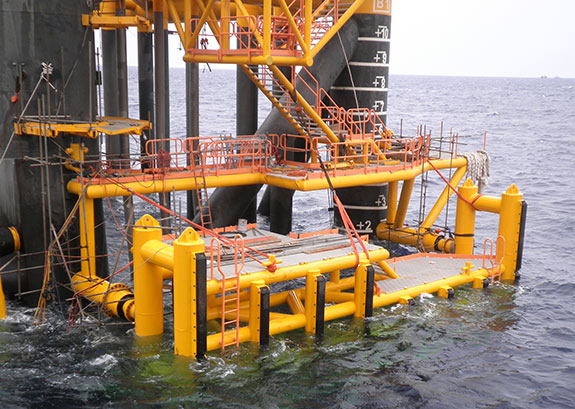Boat landing systems: making the most of maintenance
The selection of the right products for use on an offshore platform is vital - something that should remain a priority throughout the platform’s life, not just at the beginning design and planning stages. Otherwise the risk of failure and downtime can be significant. Similarly, if the best solutions are specified but not properly maintained during their lifecycle, the same risks can occur.
Boat landing systems (BLS) play the important role of protecting the platform and vessels when they are berthing, while resisting the corrosive elements at sea and operating in even the most severe weather. Therefore it’s imperative that they’re always performing. Here, Trelleborg details the benefits of working directly with a BLS manufacturer to get the most value and safety out of your maintenance schedule.
Reliable protection
Installed on an offshore platform to reduce the external load of a berthing vessel, protecting the platform and vessels or barges during berthing, BLSs primarily consist of Shock Cells, Eccentric Bumper Rings (EBR) and a steel contact surface or rubstrips.
The core design of a BLS revolves around EBR-mounted shock cells. These are connected to either a barge bumper or rubstrips, depending on the size of the vessels the system is required to accommodate. On impact by a berthing vessel, the steel surface of the barge bumpers or rubber surface of the rubstrips transfers the load to the EBRs and the shock cells. Kinetic energy is absorbed and dampened by the rubber components, and the load is therefore reduced so the vessel can berth without damaging the platform structure.
The strong bonding achieved between the rubber and the steel during the shock cell’s manufacturing process ensures the system will safely dissipate and reduce the external load without damaging the platform. It is an ability unique to rubber as a material to deflect normal and lateral impact and withstand the design stresses that are imposed on a platform during barge and vessel operations. Rubber, with its internal damping effect, can uniquely resist high overloads without damage.

Fending off downtime
Without a functioning BLS, vessel docking can cause major damage to the platform and the vessel’s structural integrity, resulting in huge costs and significant downtime – both of which simply aren’t an option for high value and remotely located offshore projects.
As a result, it’s critical that BLS have very low failure rates and minimal inspection requirements. However, to achieve this they need to be carefully designed and manufactured using the right materials. After manufacture, BLS must be subjected to rigorous materials and full-scale testing to make absolutely sure these mission critical components protect offshore platforms successfully over a long and demanding service life.
However, to ensure they consistently meet working demands and environmental conditions over their lifetime, they need to be maintained correctly. Therefore, it’s vital that BLS maintenance is given the importance it deserves.
Minimising maintenance
BLS systems come under general inspection during routine maintenance schedules of the entire platform, but this is a task usually carried out by a maintenance contractor. If not surveyed accurately, the BLS could develop cracks in its rubber, de-bonding of the rubber and pipe, deformation and corrosion.
Operators and contractors can reduce the degradation risks associated with boat landing systems by working directly with an experienced product manufacturer. Specifically, a leading manufacturer that offers maintenance surveys as an added service to ensure peace of mind that BLS in situ are reliable, tailored to the demands their likely to face and perform for the long-term.
With that said, it is critical that maintenance surveys comprise stringent checks for:
Maintenance from the manufacturer
In reducing the external load of a berthing vessel, BLS are fundamental to the protection of offshore platforms and vessels during berthing. Often utilised for projects in remote locations, it’s imperative that they’re robust, reliable and importantly, always performing.
Therefore, for operators and contractors, finding a leading manufacturer for the maintenance of its BLS with a proven track record for durability and reliability is crucial. This is because doing so guarantees complete product expertise, improved reliability and reduced risk of downtime.
From best practice design, manufacture and testing, to full in life support, leading manufacturers can help to establish and implement a best practice maintenance regime. With an expert knowledge of BLS, they can offer unrivalled understanding and expertise about the product, ensuring that extra eye for detail, ideal during maintenance surveys. In addition, should the product need to be repaired or replaced, they can supply the most suitable solution on a project-by-project basis.
For more information on how good maintenance practices can benefit your topside, download Trelleborg’s ‘Boat Landing Systems: Maintenance Service’ brochure: http://trelleborg.tecs1.com/boatlandingsystems
Read the article online at: https://www.oilfieldtechnology.com/offshore-and-subsea/24082016/boat-landing-systems-making-the-most-of-maintenance/
You might also like
Perenco completes acquisition of oil and gas fields from Woodside Energy in Trinidad & Tobago
Perenco has announced the completion of the acquisition of the Greater Angostura producing oil and gas assets and associated production facilities from Woodside Energy in Trinidad & Tobago. The finalisation of the deal, combined with Perenco’s existing operation of the Teak, Samaan and Poui (TSP) and Cashima, Amherstia, Flamboyant and Immortelle (CAFI) fields, aligns Perenco as a major oil and gas producer in country.


